Leland Stanford Junior University Football Offensive Preview
Cal has won the last 3 Big Games. Can they make it 4 on Saturday, and rob the Class of '24 from ever experiencing the joy of a Big Game victory?
Listen, it’s Big Game week. Let’s just get this out of the way first: Stanford sucks. Am I going to get death threats for accurately evaluating their team’s talent level, the way I did for Auburn, Florida State, Miami, and Pitt? Probably not. That’s just a numbers game; given that the American Psychological Association reports that 1% of the population has severe psychopathy, and Stanford has about 50 football fans max, I am probably safe.
I also have trouble hating on Stanford these days. It used to come naturally to me. Unfortunately, I am still grateful that Stanford dragged us into the ACC so that Cal can remain a power-4 conference team, instead of being on the outside looking in (like Oregon State and Washington State).
So with that said, I implore you not to look into the background of any crowd shots at Stanford Stadium. Stanford is a friendly rival. I will save my enmity for UCLA in 2026, or for USC any time I accidentally see them on TV. Besides, Stanford is having a tough enough time as it is:
It’s hard to fathom the inner turmoil of a Stanford fan, but if I had to guess, it might be related to the fact that a small meal at Taco Bell now costs $22. (Not because they can’t afford it, but because their dad’s private equity firm predicts that these prices are harmful for long-term shareholder value). I hear that you don’t even get a discount when you place an order directly with headquarters:
After snapping a 6 game losing streak, and winning their first home game against an FBS team since 2022, the team has a lot to celebrate, and the fans went wild:
2024 marks the 127th Big Game. No matter how disappointing a season is, it can always be somewhat redeemed with a Big Game win. Cal still needs this game for bowl eligibility, while Stanford has nothing left to play for but spite. There’s likely nothing I can tell you here about Stanford that you don’t already know. Unless you’re a casual observer who came across this article on accident, in which case I really need to stress to you that Stanford sucks. It’s the 20th anniversary of the 2004 Big Game, where JJ Arrington, Marshawn Lynch, and Aaron Rodgers obliterated Stanford 41-6. Wouldn’t it be cool if you could see these guys in person? Say, at a Big Game bonfire?
Former Cal quarterback and current Stanford head coach Troy Taylor is leading a unique offense down on the Farm. Advanced metrics might tell you that Stanford is one of the worst teams in the country, with a bottom-15 ranking in offensive yards per game, and a bottom-15 ranking in scoring defense. But it’s the Big Game. You can throw advanced stats out the window. The fact that Cal is a 14-point favorite is meaningless. Even a blind squirrel finds a nut, or something to that effect.
With generic platitudes out of the way, let’s take a more detailed look at the offense.
Quarterback
Stanford will rotate between quarterbacks, and multiple quarterbacks have taken snaps in every game this year but one (Virginia Tech, where one QB was injured, but they did have an RB throw a pass in that game instead). Further, there is only one game this season in which only one player has all the pass attempts: Stanford’s 26-24 win over Syracuse. With that said, Stanford’s primary quarterback this season is Ashton Daniels.
I thought Daniels had made strides as a passer last season, so I am a little baffled as to the change in the offensive direction for Daniels, who is now more of a run-first quarterback. Daniels has 205 pass attempts to 110 carries so far this season, down from 325 pass attempts to 110 carries last season—meaning he went from roughly 1:3 rush/pass attempts to 1:2 rush/pass attempts this season. Daniels has the 12th most rushing attempts in the conference, and is 1st in rushing attempts amongst amongst quarterbacks. Daniels has at least as many rushing attempts as completions in 6 of his 8 games this season against FBS competition, and more rushing attempts than pass attempts in 2 of those (both blowout losses). Not to conflate causation and correlation, but Stanford has been most successful in games where Daniels has effectively thrown the ball, so the large number of rushing attempts may signify that when he struggles to complete passes, he takes off instead.
With Daniels’s newfound reliance on his running ability, I feel like his development as a passer has suffered. Although Daniels still moves well in the pocket and likes to throw off-platform, a lot of those throws are lacking some of the accuracy I saw last year, and so I really don’t have that many highlights to showcase. Here’s one such throw where he made a nice throw on the run (in Stanford’s first game of the season):
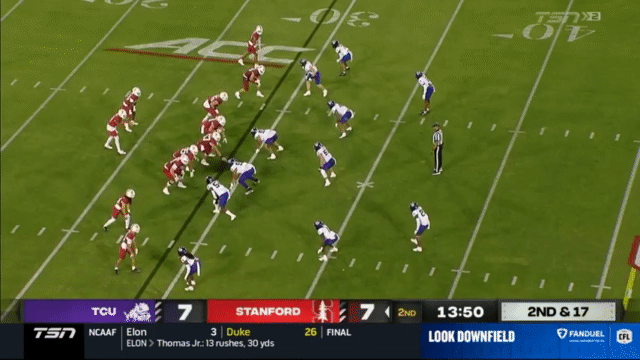
Daniels generally stays calm under pressure and keeps his head up to make a play:
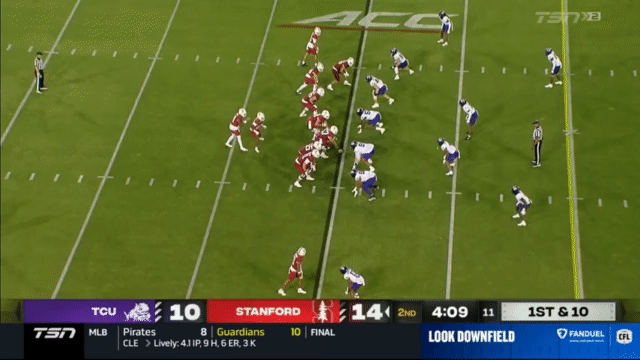
Perhaps due to the expendable nature of Stanford’s quarterbacks, Daniels is absolutely willing to take a shot in the pocket if it means he can get a throw off:
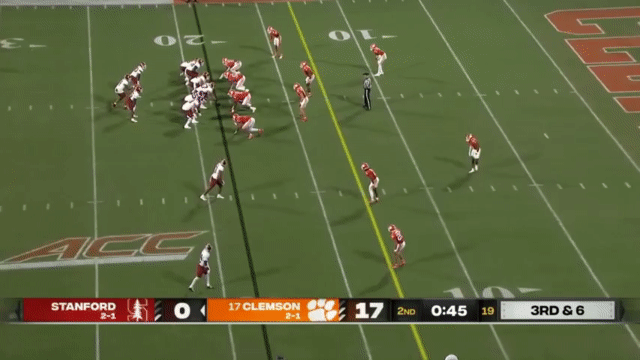
Daniels will throw off-platform quite often, either because he’s scrambling away from pressure, or because he just doesn’t want to set his feet. This results in a lot of “go get it” type throws to his receivers (and a lot of turnover-worthy plays):
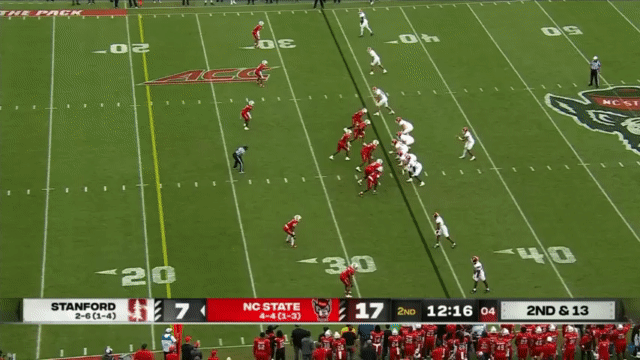
Daniels’s inconsistent throwing mechanics and his tendency to throw off-balance means that he often doesn’t properly step into his throws, relying on upper body strength instead. As a result, Daniels very often underthrows the deep ball:
Often when Daniels is looking to throw deep, the ball will hang in the air forever with the way Daniels lobs it up, giving the defense ample time to react and make a play on the ball:
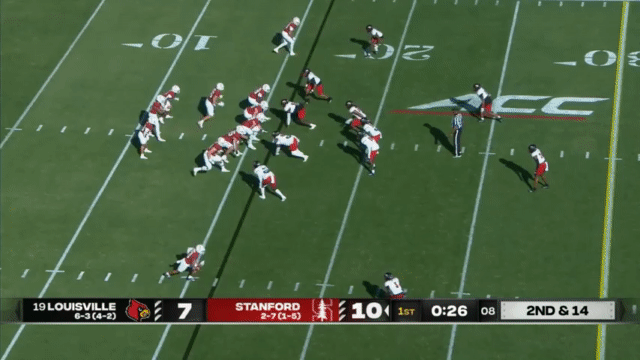
It’s even easier for the defense to make a play on the ball as Daniels will often telegraph his shots:
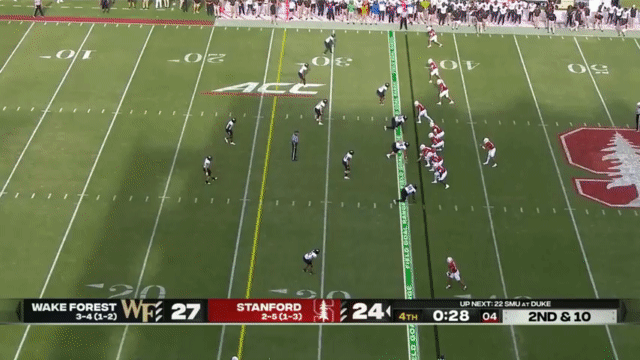
While Daniels may stay calm under pressure and be willing to sit in the pocket to make a throw, that is not to say that pressure can’t affect the throw:
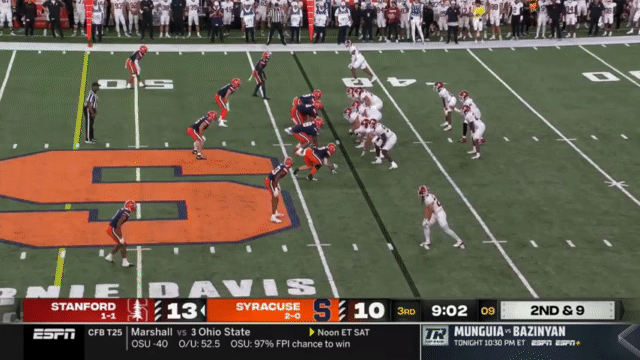
Daniels might get away with the above throw when he has a contested catch specialist in Elic Ayomanor downfield, but you can’t really expect your undersized running back to do so.
Daniels hasn’t been particularly strong in making reads or decision-making this season. Here his hesitancy to pull the trigger results in an interception:
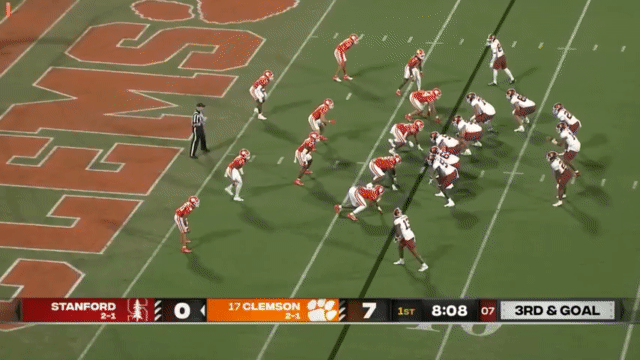
And again here he has a receiver open, but waits too long to pull the trigger and again puts way too much air under the throw:
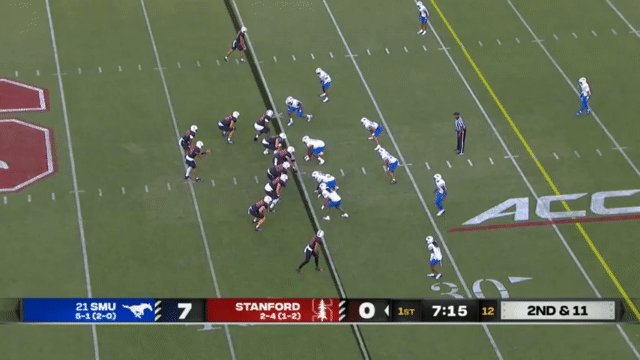
Here Daniels doesn’t see the field for another ill-advised throw:
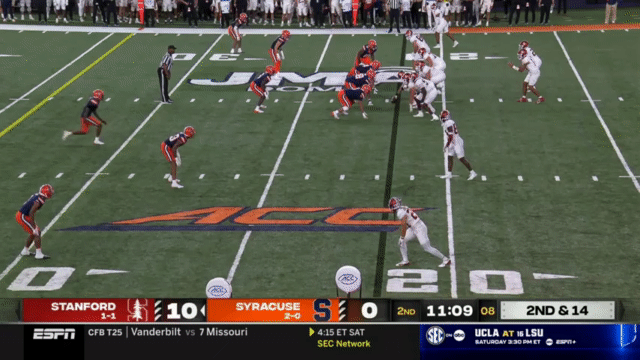
I’m not even sure what went wrong on the following play. Either Daniels was trying to throw it away and didn’t put enough on the throw to get this one out of bounds (which is what I think happened), or he thought he had a chance at a making a play here and lobbed this into traffic. The fact is that I can’t actually be sure what the intention is here based on the rest of his play:
Stanford likes to commit extra blockers (e.g. multiple TE sets) to run- and pass-block, which means that their receivers are often outnumbered in passing situations. Perhaps this explains Daniels’s over-eagerness to throw into traffic, because he often doesn’t have many other options:
True freshman QB Elijah Brown has shown a lot of promise (although I’ve been wrong before) and has seen action in 3 games so far this season. I am not sure if this is a coincidence or not, but with 2 games left on the schedule, Stanford may be intending to keep his redshirt (meaning he can play one more game before burning the redshirt). Brown is the most serious passing threat of the Stanford quarterbacks, and would probably necessitate a change in the defensive game-plan were he to play, as his passing ability needs to be respected. Brown has shown the ability to get the ball out on time (in contrast to Daniels, who often hangs on to it too long) as well as the ability to hit his receivers in stride:
However, any true freshman quarterback will have growing pains, and he did struggle on the zone read RPO which is a staple of the Stanford offense:
Similarly, he needs more experience in the new offense:
This one is not much better:
Last year, when Daniels was the “passing QB”, Justin Lamson was the “running QB”. This year, with Daniels as a running QB, Lamson is the… run even more QB. He did play as a traditional QB in two games this season: against Virginia Tech (when Daniels was injured), and against NC State (after Daniels was benched— Elijah Brown took over the SMU game when Daniels was benched in that one). Although the following play takes advantage of what the defense thought was going to be a QB sneak, it shows that Lamson still has the ability to put some nice placement on the throw:
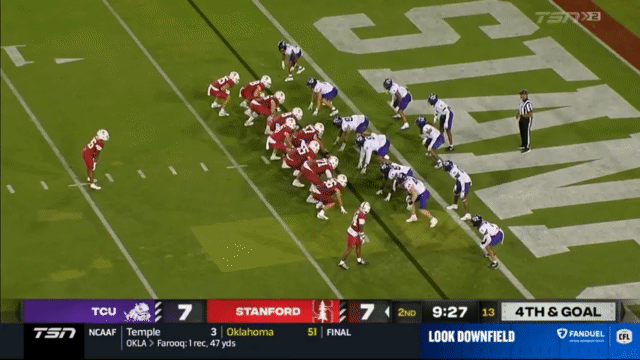
Here Lamson shows some nice pocket movement and puts some velocity on the throw, which hasn’t been seen all that much this year:
However, Lamson can still let some of his throws get away from him:
And here’s just a bad read, showing that the poor decision-making isn’t limited to one quarterback here:
Quarterback again (but this time they’re running)
Stanford likes to run the ball with their quarterbacks a lot, and it’s one of the only facets of their offense that they’ve been able to rely on, so I thought it was worth taking an even deeper look here. It’s also surprising that their quarterbacks have managed to stay healthy with the number of carries and hits they take each game (which is something that might dissuade you from running your QB so often, but since Stanford rotates through their quarterbacks, they’re not as worried about risking injury to the star QB when they have QB 1b and 1c on the sidelines ready to go). Stanford quarterbacks account for 182 of Stanford’s 365 rushing attempts this season (49.9%). Half of Stanford’s rushing attempts going to a quarterback is an absurd stat— what is this, a service academy?
While Daniels’s passing has suffered, his running has reached a new level, and Daniels is incredibly dangerous running the ball. His 110 carries in 2023 went for 296 yards (2.7 yards/carry), but has jumped to 515 yards in 2024 (4.7 yards/carry). An empty backfield usually indicates a passing situation, but not so for Stanford, who will often run the quarterback in such scenarios:
Daniels is both elusive in space, shows nice cutting ability, and is willing to run through contact:
Daniels is even a homerun threat out of the backfield:
Stanford hasn’t been particularly adept at blocking this season. PFF gives Stanford a 58.9 grade in pass blocking and a 53.4 grade in run blocking (Cal’s are 62.8 pass block and 52.8 run block, for comparison), and so Stanford will often use motion and misdirection to try to give their running QBs space:
Daniels’s running ability means that he can extend plays with his feet, buy time, and scramble when he can’t find anyone open (which is often):
Daniels also shows some pretty good vision:
Stanford’s go-to play in short yardage situations is Justin Lamson, usually on the QB sneak. Lamson has 5 of these TDs which all look basically the same:
However, head coach Troy Taylor loves trick plays, and what better time the to break tendencies than during the Big Game?
Running back
Here’s a wild stat: through the first 10 games of the season, Stanford running backs account for exactly zero Stanford touchdowns. Yes, both rushing and receiving. The running backs combine for a total of 162 rushing attempts, or roughly 44.3% of carries. That means that if Stanford is running the ball, it is more likely than not that someone other than an RB is running the ball (usually a QB or a WR on a jet motion). Stanford may have some talented backs, but with poor run blocking this season, they haven’t had all that much chance to showcase that ability.
In my opinion, their most dynamic running back is the true freshman Chris Davis Jr.:
Davis Jr. will run through contact:
And this one doesn’t go for a big gain, but a very clean stiff-arm on display:
He doesn’t have true breakaway speed, but he can still break off a big run:
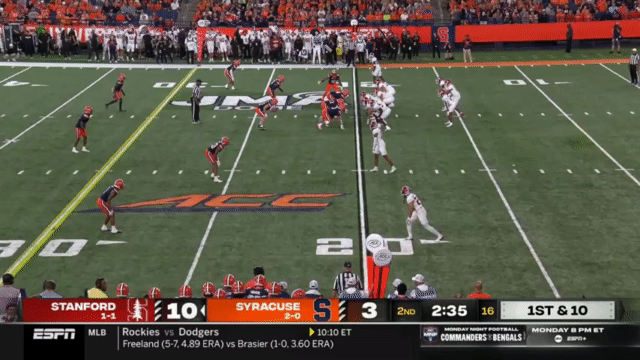
I’m also a fan of true freshman Micah Ford, who runs with a power running style and often refuses to go down on first contact. Also not a homerun hitter:
But he will run through tackles and churn out extra yards after contact:
Ford has also shown some decent receiving ability, and may be a target out of the backfield. Here he runs through a pair of tackles:
Also of note is that Micah Ford was a quarterback in high school, and he was used as such in the following trick play:
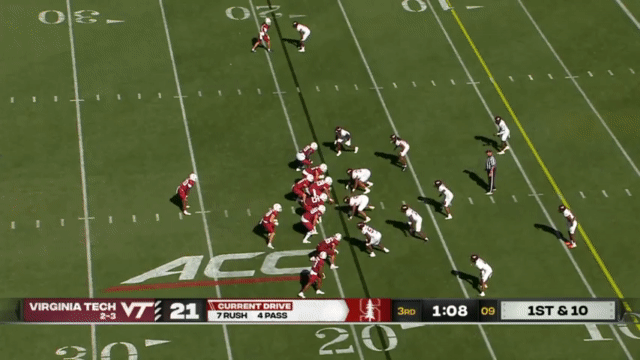
Stanford has a young running back room, and somehow sophomore Sedrick Irvin is the most veteran back (if you define “veteran” as “has the most carries for Stanford in prior seasons” so that I can exclude Ryan Butler who had a lot of carries at an FCS school). Irvin has appeared in a couple of highlights this season (Ctrl+F his name in this article), but no highlights of him running. So in the interest of inclusivity, I found his longest run of the season, which was this 19 yard carry against Clemson backups:
I think Irvin is a decent back, but he’s been lost in the rotation this year as Stanford has given some freshmen the bulk of the carries at RB.
The formerly bulkiest back in the backfield for Stanford was the Princeton transfer, Ryan Butler, who was listed last year at 225 lbs. Stanford’s official roster this year has him slimmed down to a listed 210 lbs. However, he still has that same power-running style:
The 4-star freshman Cole Tabb is 5’8”, but boasts a powerful frame and track star speed, having competed for his high school’s track and weightlifting team. Tabb has entered the rotation these past two games, seemingly indicating that Stanford was saving him to be redshirted. I haven’t really seen enough of him to form an opinion yet, but he did have this nice run against NC State:
I am going to go out on a limb here and say that it’s unlikely that the running backs will have a meaningful impact on this game (unless it’s a single miraculous big play to change the game or something). The above section was purely informational, and I strongly considered omitting it entirely after the “Quarterback (running)” section in the interest of brevity. Fortunately, I am not interested in brevity.
Receivers
If you’ve watched a single Stanford game in the past two years, you heard the announcers talk endlessly about a single player: Stanford wide receiver Elic Ayomanor, whose name sounds like something from an Elvish RPG. This is likely because of the absolute dearth of talent at Stanford has, which left announcers no one else to talk about, and their script must continue even as defenses double Ayomanor to prevent him from even receiving any targets. This unrelenting media hype is probably due to the fact that Ayomanor had a single game last season with an absurd stat line against media darling Deion Sanders’s Colorado team, in which he had 294 receiving yards against an awful Colorado defense. The media hype machine blew into overdrive as Ayomanor posted those eye-popping numbers against the mega-hyped WR/CB Travis Hunter, and how can anyone post those absurd numbers against a Heisman candidate unless they themselves are also deserving of mega-hype? Could it be that Travis Hunter was injured and exhausted, and hence played poorly during his 157 snaps in his first game back after being out for 3 weeks with an injury? Of course, this highlight reel catch didn’t help.
That’s not to say Ayomanor isn’t a good receiver. Of course he is; he’s an NFL talent. I just can’t stand the endless blathering about how Ayomanor is the best thing ever. If I had to guess (and you can hold me to this next April), I’d say he’s probably a 3rd round NFL Draft pick, and maybe he sneaks into the second round in a weak WR draft class.
Ayomanor is an NFL talent because of his physical attributes; his straight line speed, his strong hands, and his ability to high-point the football make him an attractive NFL Draft pick as a contested catch specialist, as separation comes at a premium in the NFL. Ayomanor absolutely has the ability to make highlight reel catches like this:
Overall, I am generally not impressed with Ayomanor’s route running ability, and he often fails to get separation from sticky corners. Most of Ayomanor’s separation comes from literally shoving off defenders and counting on the refs not to throw a flag. However, this lack of separation doesn’t matter when he’s bigger and stronger than those corners:
Opposing corners generally give Ayomanor a large cushion, and he uses his speed to make this corner pay:
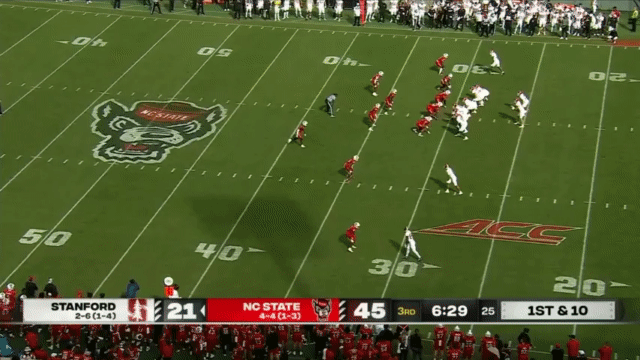
You have to be really sure of yourself if you’re going to try to jam Ayomanor at the line:
Generally, defenses are happy to give Ayomanor short completions so that they don’t give up the big play, but that also relies on your ability to make the tackle on Ayomanor in open space, and that’s not a given considering his size and strength:
A lot of Ayomanor’s big gains are on throws where he takes advantage of the defense’s willingness to give him short completions:
When Stanford is desperate for a play, Ayomanor is the first and only target. The QB will lob it up and trust that Ayomanor is down there somewhere:
I can’t emphasize enough how obvious it will be who the target is if the game is close in the 4th quarter. It’s Ayomanor. It’s always Ayomanor. You’d have to pull a real Syracuse to leave Ayomanor in single man coverage to the outside after Ayomanor has caught 5 straight catches on that drive. The ball is going to Ayomanor. The QB is going to lob it up and trust Ayomanor to catch it.
Ayomanor may be known for his strong hands, but he’s not perfect:
With most defenses game-planning around Ayomanor (bracketing him, safety help, etc), that leaves plenty of opportunity for WR #2, who will likely only have one defender to beat as a result of the attention on Ayomanor. Stepping into that role is the new clear WR #2, Emmett Mosley V, who had almost half of his season’s 361 yards in last week’s 13 rec/168 yards/3 TDs performance against Louisville. Mosley was not a particularly reliable receiver until last week’s matchup, when he posted those 13 catches on 14 targets (he had 22 catches on 34 targets—59.5%—prior to the Louisville game).
The worst part about all this is that I can’t even make a Stanford legacy joke about Emmett Mosley being the fifth of his name after learning that Fernando Mendoza is the fifth of his name as well. Fernando Mendoza has taught me a hard lesson, which is that even though a lot of Stanford legacies have dynastic names (e.g. John Edward Toner V, i.e. Jet Toner, i.e. Mr. Printer, i.e. Mr. Out of Ink, i.e. Please Check Paper Tray), they are not bad people because of it. They are bad people because they chose to attend Stanford instead of the obvious superior University of California, unlike Fernando Mendoza V (long live Fernando V, and down with France).
What was I saying? Oh yeah, something about Stanford. With Mosley often left in single man coverage, he only needs to beat one defender. Here he come up clutch with this great catch to keep Stanford alive:
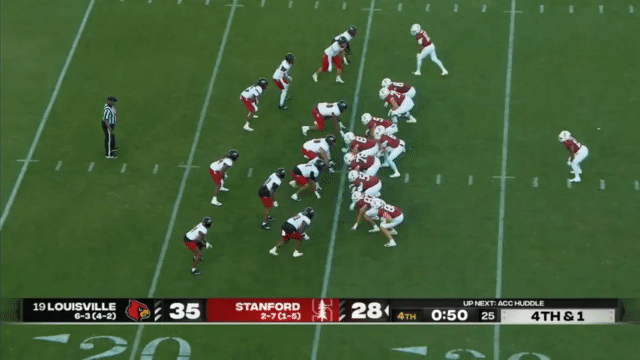
Here Mosley makes a nice double move and a nice catch to adjust to this throw for a touchdown:
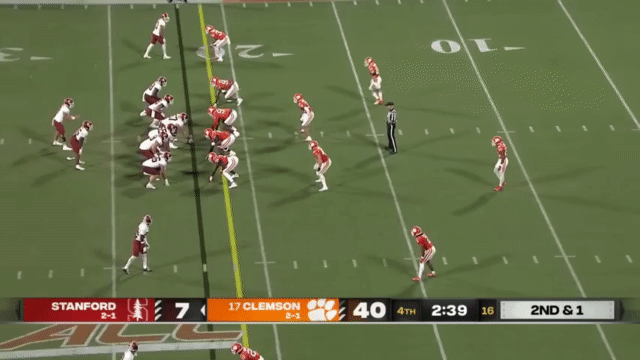
Although Mosley hasn’t seen a lot of success as a deep threat receiver, he has done some damage with yards after the catch:
Mosley had a lot of targets in the game against SMU, but he had an uncharacteristically large number of drops:
And again:
Stanford will generally try to scheme Mosley open on short to intermediate routes, particularly over the middle of the field.
The other frequently targeted receiver is the tight end, Sam Roush, who is a staple target on short routes underneath. Roush forces missed tackles at a higher clip than any other Stanford receiver:
Here is a better example where he keeps his feet despite the numerous tackle attempts:
Again, a short throw underneath, catch and run by Roush:
Prior to Mosley’s breakout performance, it was WR Ismael Cisse as the target on the outside:
Cisse has also shown the ability to adjust to inaccurate throws, an important skill for any Stanford receiver:
One player that I thought would be an impact player this season but has instead been largely absent is Mudia Reuben. He’s shown a lot of talent in brief flashes of play, but has instead only played a handful of snaps, and I have no idea why. Reuben has always been a reliable receiver:
Backing up Mosley is the redshirt freshman and Berkeley High grad Jackson Harris:
There are two big name receivers for Stanford who I should have talked about, but have made minimal impact this year (and hence the lack of highlight clips): Bryce Farrell and Tiger Bachmeier (both of whom were covered in last year’s article here). Farrell and Bachmeier were slot receivers last year, but Bachmeier has mainly lined up wide this year (I am assuming Farrell is injured or something, because he has barely cracked the lineup otherwise). Bachmeier has 356 offensive snaps (plus 92 on special teams), but only 9 catches on 16 targets. On 356 snaps. Bachmeier was an impact player last year (and still their primary special teams player on punt/kick returns), but has become an afterthought in the offense. I have no explanation.
Stanford has some decent talent at wide receiver, but the limiting factor here is the passing. I think that with better passing, some of these receivers would have more to show for it.
Conclusion
Stanford beat Syracuse early in the season, and also beat a decent Louisville team (CFP ranked #19 at the time) last week. Both of those wins concern me, but… those are Stanford’s only FBS wins this season. They lost to Wake Forest, and were completely blown out by Clemson, Virginia Tech, Notre Dame, SMU, and NC State; so the transitive property probably won’t apply here. Cal will need to stop QB Ashton Daniels from running the ball, and not allow WR Elic Ayomanor to make big plays. Stanford’s offensive line is suspect at best, with liabilities at center and left tackle (a true freshman), and so Cal will hopefully get sacks and TFLs to disrupt Stanford drives. Stanford’s secondary is also a liability, but their front-seven—led by OLB David Bailey—will also surely get pressure on Mendoza for sacks and negative plays. Anything can happen in a rivalry game, and the previous 10 games don’t matter, but Cal should have the talent advantage here. The weather report currently forecasts rain, which would favor Stanford (with their reliance on the QB run game and weakness in pass defense otherwise), but Cal should have a solid homefield advantage with a sold-out crowd. I should know—because I will be there—and I hope that you will too.
Go.
Bears.
You can find my full clips here.



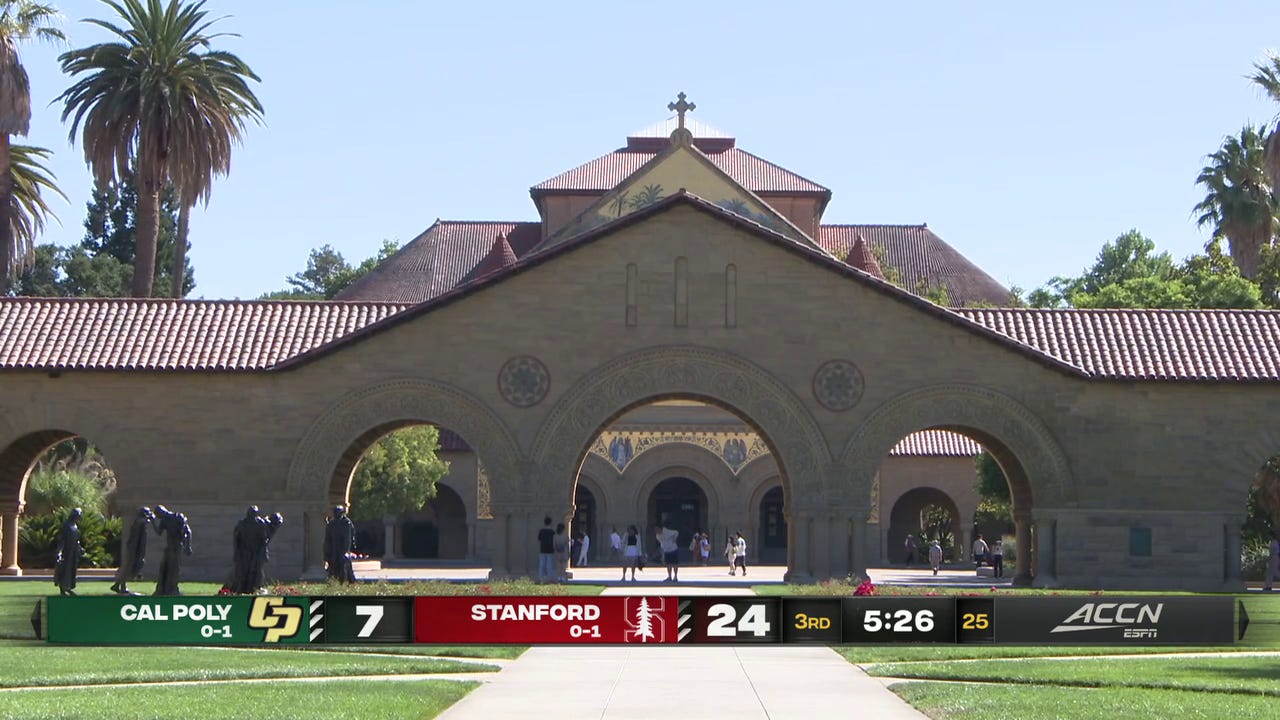

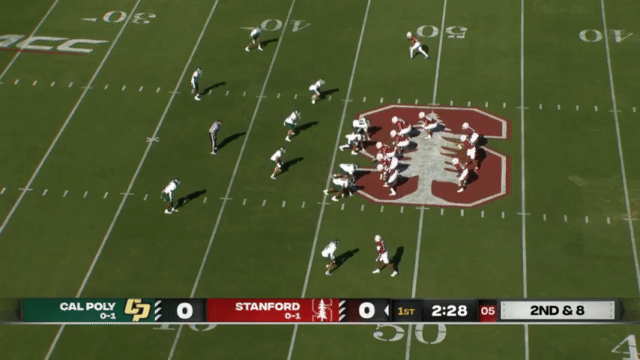



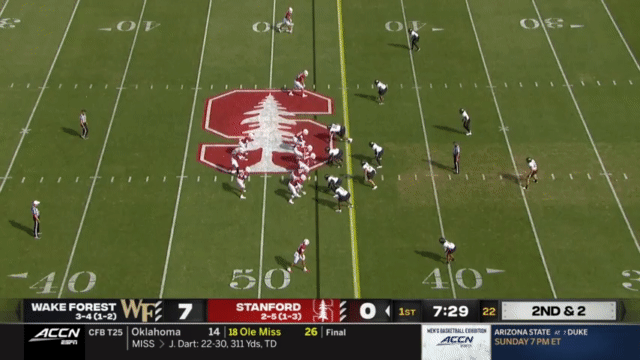

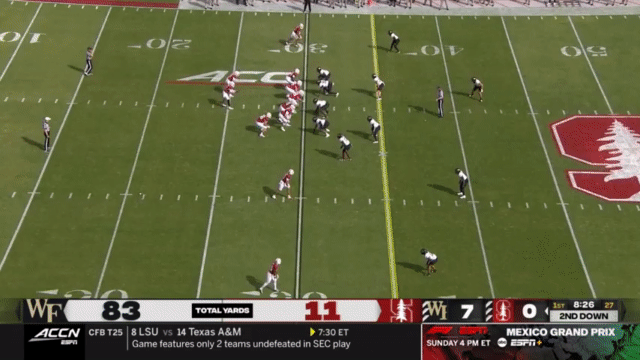





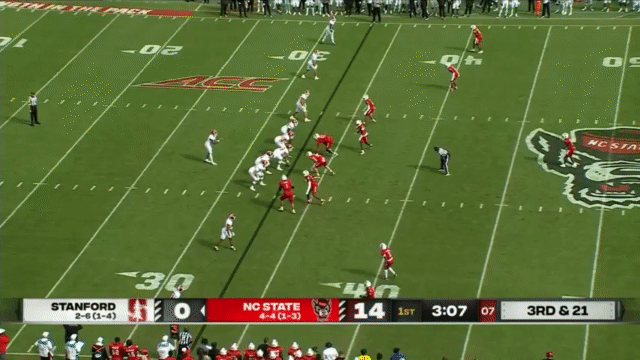









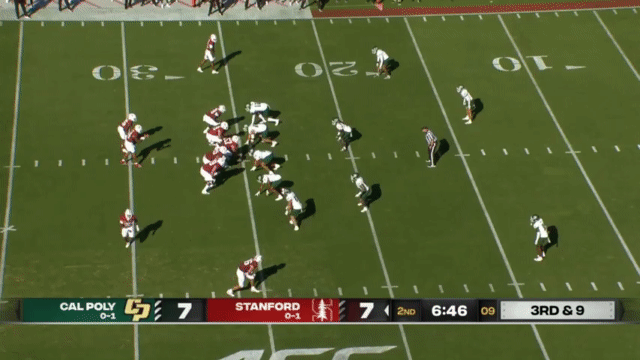




















Nice work Chistopher, I always learn something from your previews. I don't hate Stanford really, I just want the Cal football team to beat the Stanford football team by 21 points or more this Saturday rain or shine. Is that too much to ask for? I think not. Go Bears! Let's wrap up the home game season on a positive note.
Thanks Christopher!! Great stuff.